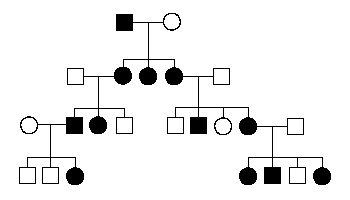X-linked Dominant Inheritance - Example
Pedigree

The X-linked dominant pattern is rare. Both males and female offspring of an affected female can have the trait. All female offspring of affected males will exhibit the disease, but male offspring will not. For the standard X-linked dominant condition, twice as many females will be affected as males, though half of affected females may have a milder form of the disease, because they have one unaffected X chromosome.
Fragile X Syndrome

This disorder illustrates an unusual inheritance pattern that depends upon differences in male and female transmission. Fragile X syndrome is an X-linked dominant disorder, but is another example of a tandem repeat (CGG triple repeat) disorder involving a gene, the fragile X mental retardation 1 (FMR1) gene that codes for a protein in the CNS. The abnormal gene may lead to mental retardation. Normally, there are fewer than 50 repeats. Persons with 50 to 200 repeats transmit the disease, but do not express the disease. Even though it is dominant, twice as many males as females are affected. This is due in part to X inactivation with reduced penetrance and expression in females. It is also because the risk for the disease increases if you are a male born to a woman who is a carrier. In females passing the trait, the number of repeats expands. The more repeats that are present, the more likely the expansion in female transmission will exceed 200 repeats. Thus, the number of affected males increases in successive generations. Males as carriers with fewer than 200 repeats will pass the same number of repeats to all their daughters, but those daughters will pass expanded repeats to their offspring. More recent generations are more severely affected, a phenomenon called anticipation. The above oversimplified pedigree illustrates this phenomenon, though in reality, smaller repeats are likely added over more generations.


